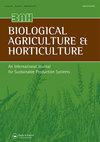Potential for no-tillage and clipped-weed mulching to improve soil quality and yield in organic eggplant production
IF 1.6
4区 农林科学
Q3 AGRONOMY
引用次数: 18
Abstract
ABSTRACT Deep-inversion tillage for weed control and residue incorporation can have a detrimental effect on agroecosystems. Despite the potential for no-tillage (NT) organic farming to improve soil quality, the yield response of NT can vary. This study compared the effects of NT and conventional rotary tillage (CT), leafmould application (LM+) and no leafmould (LM–), clipped-weed mulch application (CM+) and no weed mulch (CM–) on eggplant yield and crop residue (Solanum melongena L.) and on soil chemical and physical properties under standard organic farming conditions. In both years, NT CM+ resulted in higher yield and crop residue than in NT CM–. Soil bulk density was 34 and 32% lower in 2014 and 2015, respectively, in NT compared with CT. In both years, CM+ had a significant impact on the water content in the surface-layer in both tillage systems. Soil organic carbon and active carbon concentrations, at 0–2.5 cm depth, were 85 and 20% higher in NT than in CT. In October, NO3-N, exchangeable Mg2+, Ca2+ (in 0–2.5 cm only) and available P (in 0–2.5 cm only) were higher in NT than in CT in soil layers 0–2.5 cm and 2.5–7.5 cm. CM+ resulted in increased soil inorganic nitrogen in NT plots during the growing season. The results suggested that NT with CM+ application can be a valuable conservation practice for increasing yield and soil carbon in organic farming by reducing tillage intensity.免耕和修剪杂草覆盖在有机茄子生产中改善土壤质量和产量的潜力
摘要用于杂草控制和残渣掺入的深翻耕可能会对农业生态系统产生不利影响。尽管免耕(NT)有机农业有可能改善土壤质量,但NT的产量反应可能会有所不同。本研究比较了在标准有机耕作条件下,NT和常规旋耕(CT)、叶霉菌施用(LM+)和无叶霉菌施用、修剪杂草覆盖(CM+)和不杂草覆盖(CM-)对茄子产量和作物残留(茄属)以及土壤理化性质的影响。在这两年中,NT CM+的产量和作物残留量都高于NT CM-。2014年和2015年,NT的土壤容重分别比CT低34%和32%。在这两年中,CM+对两种耕作系统表层的含水量都有显著影响。在0–2.5 cm深处,NT的土壤有机碳和活性碳浓度分别比CT高85%和20%。10月份,在0–2.5cm和2.5–7.5cm土层中,NT的NO3-N、可交换性Mg2+、Ca2+(仅在0–2.5%)和有效磷(仅在0~2.5cm)均高于CT。生长季节,cm+导致NT地块的土壤无机氮增加。结果表明,施用CM+NT可以通过降低耕作强度,在有机农业中提高产量和土壤碳含量,是一种有价值的保护措施。
本文章由计算机程序翻译,如有差异,请以英文原文为准。
求助全文
约1分钟内获得全文
求助全文
来源期刊
CiteScore
3.30
自引率
6.70%
发文量
18
审稿时长
>36 weeks
期刊介绍:
Biological Agriculture & Horticulture aims to act as the central focus for a wide range of studies into alternative systems of husbandry, and particularly the biological or organic approach to food production. The Journal publishes work of a sound scientific or economic nature related to any aspect of biological husbandry in agriculture, horticulture and forestry in both temperate and tropical conditions, including energy and water utilization, and environmental impact.

 求助内容:
求助内容: 应助结果提醒方式:
应助结果提醒方式:


